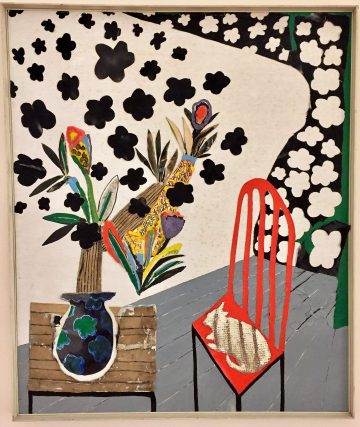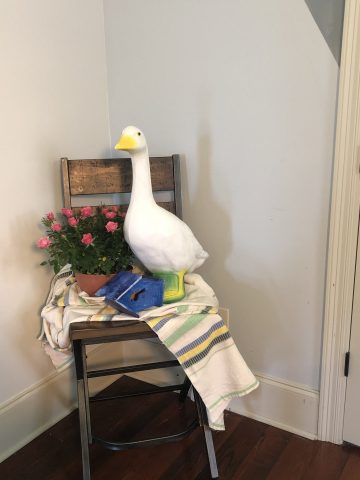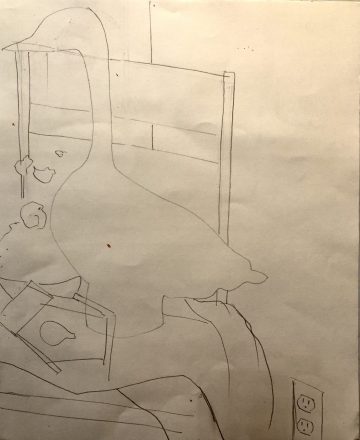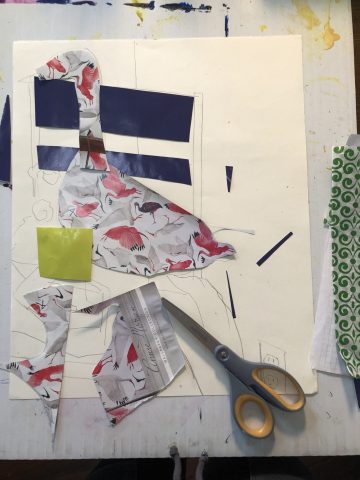Español abajo
Students will create a still life set-up in their home with a few favorite objects. They will then create a rough sketch of the still life and fill in the drawing with collage. Students will learn about arranging objects in space, drawing large shapes, cutting out fabric and paper materials and gluing scraps down well to create a still life collage.
Download Activity
Benny Andrews, Interior with Cat, 1988, Oil and collage, Gift of the Benny Andrews Foundation
Benny Andrews was raised in Georgia and went to fine arts college at the School of the Art Institute of Chicago. His father George Andrews was a self-taught artist and inspired Benny to pursue his dream of making art. Benny and George made art together throughout their adult lives. Benny Andrews made a prolific amount of artwork during his lifetime. He considered his work to be an extension of his beliefs around social justice and positive community activism.
SUPPLIES
- Thicker paper or cardboard you can glue and paint on
- White glue, glues stick or ModgePodge
- Different types of decorative and plain paper scraps (think magazines, newspapers, old wrapping or tissue paper)
- Scissors
- Pencil
- A collection of objects from around the house that the student likes
- A flat surface to set-up the Still Life
- Another area to work where students can look at the Still Life
- Paper towels or wipes for easy glue clean-up
PROCESS
-
- Have students choose 4-5 objects around their house that give them joy. Remind them to choose objects that vary in shape, size and texture.
- Ask students to arrange their objects on a small table or chair in a place where the objects will not get bumped for a few hours.
- Invite students to grab a pencil and their thick paper or cardboard and sit down to draw the main BIG shapes of the still life. Remember that this will be a collage, so remind students that they do not need to draw any details.
- After students have sketched out the big shapes on their paper, ask them to choose paper and fabric to cover the large shapes. Remind them that they can also use collage to add movement, pattern and depth into the background of the image.
- Ask students to glue all the pieces down well– a combination of a glue stick and white liquid glue works best. Remind students that gluing down the edges and corners of each piece really well makes a big difference!
- Have students complete the entire piece including collaging the background and the still life objects.
- Have students create a title for their piece and sign and date the artwork on the back.
KEY TERMS
Collage a technique using cut or torn fabric or paper and glue
Still Life an image of objects that don’t move; genre of art
Mixed Media more than one material used to create artwork, such as found objects and fabric
Pattern an underlying structure that organizes surfaces or structures in a consistent, regular manner.
Movement a principle of art used to create the impression of action in a work of art.
Background the part of the picture plane that seems to be the farthest from the viewer.
Middle ground area of a two-dimensional work of art between the foreground (closest) and the background (furthest receded).
Foreground part of a two-dimensional artwork that appears to be nearer to the viewer or “in the front” of the image.




________________________________________________________________________
ACTIVIDADES ONLINE DEL MUSEO OGDEN PARA EL AULA: INTERIOR Y GATO | BENNY ANDREWS GRADOS 2-5
Los alumnos crearán una disposición de naturalezas muertas en su hogar, utilizando algunos de sus objetos favoritos. Luego, crearán un boceto de naturaleza muerta y rellenarán el dibujo con un collage. Los alumnos van a aprender a organizar objetos en un espacio, dibujar grandes figuras, cortar telas y papeles y pegar los pedazos para crear un collage de naturaleza muerta.
Descargar Actividad
Benny Andrews, Interior with Cat, 1988, Oil and collage, Gift of the Benny Andrews Foundation |Benny Andrews, Interior y Gato , 1988, óleo y collage, obsequio de la Fundación Benny Andrews
Benny Andrews fue criado en Georgia y asistió a la facultad de bellas artes del Instituto de Arte de Chicago. Su padre, George Andrews, fue un artista autodidacta e inspiró a Benny a perseguir su sueño de hacer arte. Benny y George hicieron arte juntos durante toda su vida adulta. Benny Andrews hizo una cantidad prolífica de arte durante toda su vida y consideraba que sus obras eran una extensión de sus creencias sobre la justicia social y el activismo comunitario positivo.
MATERIALES
- Un papel grueso o cartón sobre el que puedas pegar y pintar
- Pegamento blanco, pegamento en barra o Mod Podge
- Distintos tipos de recortes de papel decorativo o liso (pueden ser revistas, periódicos, papel de regalo viejo o pañuelos de papel)
- Tijeras
- Lápiz
- Una colección de objetos que estén en el hogar y que a los alumnos les gusten
- Una superficie lisa para organizar la naturaleza muerta
- Otro espacio de trabajo en la que los alumnos puedan observar la naturaleza muerta
- Servilletas o toallas para limpiar el pegamento
PROCEDIMIENTO
1. Pídeles a los alumnos que elijan 4 o 5 objetos que estén en sus casas y que les traigan alegría. Recuérdales que elijan objetos que sean de distintas formas, tamaños y texturas.
2. Pídeles a los alumnos que organicen sus objetos en una mesa o silla pequeña en un lugar donde éstos puedan permanecer quietos por algunas horas.
3. Invita a los alumnos a tomar un lápiz y un papel grueso o cartón y pídeles que se sienten a dibujar las formas principales más grandes de la naturaleza muerta. Como esto será un collage, recuérdales a los alumnos que no es necesario dibujar detalles.
4. Luego de que los alumnos hayan bocetado las formas más grandes en el papel, pídeles que elijan un papel o tela para cubrir las formas grandes. Recuérdales que también pueden utilizar el collage para agregar movimiento, patrones y profundidad en el fondo de la imagen.
5. Pídeles a los estudiante que peguen muy bien todas las piezas: la combinación de pegamento en barra con pegamento líquido blanco es lo que mejor funciona. ¡Recuérdales que pegar muy bien los extremos de cada pieza realmente hace una gran diferencia!
6. Pídeles a los alumnos que completen toda la pieza, incluídos el collage en el fondo de la imagen y los objetos de la naturaleza muerta.
7. Haz que los alumnos piensen un título para su obra, lo firmen y le pongan la fecha en la parte de atrás.
TÉRMINOS IMPORTANTES
Collage: técnica que consiste en cortar o rasgar pedazos de tela o papel y pegarlos.
Naturaleza muerta: una imagen de objetos que no se mueven. Género artístico.
Técnica mixta: la utilización de más de un material para hacer obras de arte, como por ejemplo objetos encontrados y tela.
Patrón: es una estructura subyacente que dispone superficies o estructuras de manera consistente y uniforme.
Movimiento: principio artístico utilizado para crear la impresión de acción en una obra de arte.
Fondo: la parte del plano pictórico que se encuentra más lejos del observador.
Plano medio: área de obra de arte bidimensional entre el primer plano (lo más cercano) y el fondo (más alejado).
Primer plano: parte de una obra de arte bidimensional que aparenta estar más cerca del observador o “en frente” de la imagen.




